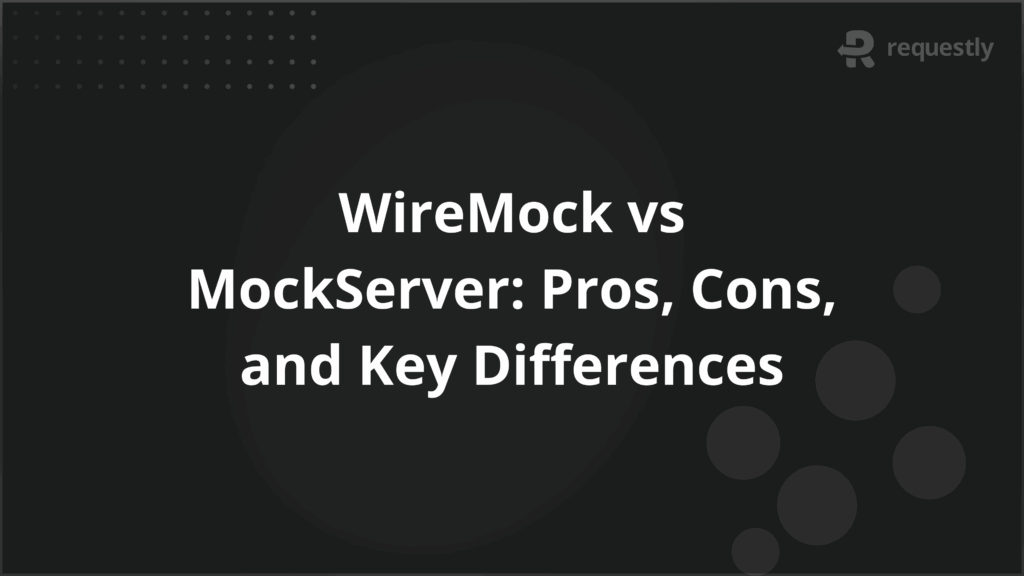WireMock vs MockServer: Pros, Cons, and Key Differences


WireMock and MockServer are two widely used tools for mocking APIs and HTTP services that help developers test applications without relying on live services. Both tools allow you to simulate real-world API behavior, providing a way to test various scenarios without making actual network requests.
Though their goals are similar, the tools differ in their features, setup processes, and best-use cases. This guide compares them directly, highlighting their strengths, weaknesses, and the specific situations in which each excels.
What Is WireMock? Key Features and Use Cases
WireMock is a tool designed to simulate HTTP-based services. It allows developers to create mocks and stubs for HTTP requests, enabling testing of services that rely on external APIs. By mimicking responses from these APIs, WireMock makes it possible to test applications without needing the actual external services to be available.
Key Features of WireMock:
- HTTP request and response simulation: WireMock can simulate requests and define responses based on various conditions like URL, headers, and query parameters.
- Stateful behavior: It supports stateful scenarios, where the mock server can remember previous interactions and adjust future responses accordingly.
- Record and playback: WireMock allows recording actual requests and responses, then playing them back in a testing environment.
- Flexible configuration: You can configure WireMock using a REST API or Java client, offering flexibility for different types of projects.
Common Use Cases for WireMock:
- Testing third-party API integrations when the real APIs are unavailable or unreliable.
- Simulating complex API responses that might be difficult to reproduce in a real environment.
- Developing and testing services that interact with external systems, especially during development stages when these systems may not be accessible.
What Is MockServer? Key Features and Use Cases
MockServer is another tool designed to mock HTTP and HTTPS requests. Like WireMock, it is aimed at improving testing efficiency by simulating real-world server behavior. It helps developers create mock servers that can handle dynamic request-response scenarios.
Key Features of MockServer:
- Request matching: MockServer offers powerful matching capabilities, allowing for complex request conditions like JSON body matching, headers, and query parameters.
- Dynamic response generation: MockServer can generate responses dynamically based on the request data, making it adaptable for different scenarios.
- Integration with CI/CD pipelines: It integrates seamlessly with continuous integration and deployment workflows, ensuring that tests can be run automatically in a CI/CD pipeline.
- Support for multiple languages: MockServer offers client libraries in Java, JavaScript, and other languages, making it versatile for different programming environments.
Common Use Cases for MockServer:
- Mocking complex services in microservices architectures for end-to-end testing.
- Testing client applications that depend on APIs that are difficult or costly to access in a development environment.
- Simulating responses from backend systems to test integration and performance without needing access to actual services.
WireMock vs MockServer: Side-by-Side Feature Comparison
When choosing between WireMock and MockServer, it’s important to understand how each tool stacks up in key areas such as setup, configuration, and the depth of features. Below are the critical features of both tools that highlight their differences.
Here is a side-by-side comparison of WireMock and MockServer based on their main features:
Feature | WireMock | MockServer |
Configuration | Java client or REST API | REST API or client libraries for multiple languages (Java, JavaScript, etc.) |
Request Matching | URL, headers, query parameters, body | JSON body, headers, query parameters, advanced matching |
State Management | Stateful interactions (tracks previous requests) | Limited state support, less advanced than WireMock |
Protocol Support | HTTP, HTTPS | HTTP, HTTPS, WebSockets |
Recording and Playback | Built-in support for recording and replaying requests | Does not have built-in recording and playback |
Integration | Integrates with Java-based frameworks like JUnit | Easily integrates into CI/CD pipelines and various environments |
Setup and Installation | Easy in Java environments via Maven or Gradle; standalone available | Simple setup via Docker, Java, or client libraries; more flexible |
WireMock vs MockServer: Setup and Developer Experience
The setup and developer experience are crucial factors when choosing between WireMock and MockServer. Ease of installation, configuration, and the overall developer-friendly nature of each tool can significantly impact testing productivity.
Category | WireMock | MockServer |
Installation | Easy setup via Maven/Gradle, standalone version available | Simple setup with Docker, Java, or client libraries (Java, JavaScript, etc.) |
Configuration | REST API or Java client (Java-focused) | REST API or client libraries (supports multiple languages) |
Request Matching | Matches URL, headers, query params, and body | Advanced matching: JSON body, headers, query params |
State Management | Supports stateful interactions (tracks previous requests) | Limited state management |
Protocol Support | HTTP, HTTPS | HTTP, HTTPS, WebSockets |
Recording and Playback | Built-in support for recording and replaying requests | No built-in support for recording and playback |
Integration | Easy integration with Java frameworks like JUnit | Integrates well with CI/CD pipelines and various environments |
Setup & Installation | Smooth for Java environments (Maven/Gradle), standalone version | Easy setup with Docker, flexible setup for various environments |
Documentation | Extensive, easy to follow | Thorough, but requires more effort for advanced features |
Learning Curve | Low for Java developers, but advanced features may require more knowledge | Steeper learning curve due to advanced matching and flexibility |
Developer-Friendliness | Simple for Java-based development, advanced setup is more complex | More flexible but requires more configuration for non-Java users |
Which Tool Has Better Community Support: WireMock or MockServer?
Community support plays a significant role in selecting the right tool for any project. Active communities ensure ongoing updates, troubleshooting resources, and a shared knowledge base. Let’s break down the community support for WireMock and MockServer to see how they compare.
WireMock:
- Community Size: WireMock has a large and active community, especially in the Java ecosystem, where it is most widely used. This tool is well-documented and supported across various forums, GitHub repositories, and developer communities.
- Resources: The WireMock community maintains a strong presence with numerous examples, blog posts, and tutorials. The official WireMock GitHub page is actively updated, and there’s a dedicated Slack channel where developers exchange tips and solutions.
- Contributors: WireMock sees regular contributions from both individual developers and organizations, which keeps it up to date with new features and bug fixes.
- Support Channels: WireMock provides official support through GitHub issues, Stack Overflow, and its documentation. There is also a strong presence of third-party resources that can help developers solve problems.
MockServer:
- Community Size: MockServer has a smaller but steadily growing community compared to WireMock. While it may not have as many active users, it is well-regarded within certain industries, particularly for microservices and integration testing.
- Resources: MockServer provides a solid amount of documentation, including examples and guides. However, the community-driven resources are fewer compared to WireMock. There is less activity on forums and fewer blog posts.
- Contributors: MockServer is actively maintained, with contributions from both developers and companies, though it has fewer contributors than WireMock.
- Support Channels: Similar to WireMock, MockServer offers support through GitHub issues and its documentation. There is a smaller community on Stack Overflow and fewer third-party resources available.
WireMock vs MockServer: Pros and Cons Breakdown
Understanding the pros and cons of each tool is essential for making an informed decision. Below is a breakdown of WireMock’s and MockServer’s strengths and weaknesses, guiding you toward the right tool for your project.
WireMock Pros and Cons:
WireMock offers several advantages such as widespread adoption and flexible configuration. However, it also has a few limitations, especially when it comes to protocol support and advanced features.
Pros | Cons |
Popular in the Java ecosystem, with many resources and tutorials available | Primarily supports HTTP and HTTPS |
Can record and replay real API traffic, useful for replicating exact scenarios | Primarily suited for Java developers, may be challenging for non-Java environments |
Supports stateful interactions, allowing for complex testing scenarios | Features like stateful behavior and recording may require more time to learn |
Works well with Java-based frameworks like JUnit | May be overkill for simple mocking needs |
Offers high flexibility in configuring request-response mappings | Can be resource-heavy for large-scale testing setups |
MockServer Pros and Cons:
MockServer provides flexibility in protocol support and request matching but comes with a smaller community and fewer built-in resources for complex use cases.
Pros | Cons |
Supports HTTP, HTTPS, and WebSockets, offering greater versatility | Has fewer users and resources compared to WireMock |
Offers fine-grained control for matching JSON bodies, headers, and more | Advanced features can be more difficult to implement due to limited examples |
Can generate responses dynamically based on request data | Lacks built-in support for recording and replaying real traffic |
Works well in CI/CD workflows for automated testing | Documentation can be unclear for advanced use cases |
Offers client libraries for Java, JavaScript, and other languages | Smaller community with fewer support options |
Common Challenges When Using WireMock or MockServer
While both WireMock and MockServer are powerful tools for mocking and testing APIs, there are some common challenges that users may encounter with either tool. These challenges can affect the ease of use, integration, and performance during testing.
1. Configuration Complexity
Both tools provide extensive configuration options, which can sometimes be overwhelming. For developers unfamiliar with either tool, setting up complex scenarios such as dynamic responses, stateful behavior, or custom request matching can take time and require careful attention to detail.
2. Performance Issues
As testing scales and the number of mock interactions increases, both WireMock and MockServer can face performance bottlenecks. Handling large datasets or high concurrency in tests can sometimes lead to slower response times or higher resource consumption, especially when running in complex environments.
3. Integration with Non-Java Environments
While both tools are primarily designed with Java in mind (WireMock for Java and MockServer with Java and other language support), integrating them into non-Java-based environments can present challenges. This may require additional configuration, adaptation, or even using third-party wrappers, which can complicate the setup process.
4. Lack of Built-In Support for Recording
MockServer, in particular, lacks built-in recording capabilities for HTTP traffic, a feature available in WireMock. This means users have to manually set up a recording system or use additional tools for capturing live traffic, which adds complexity to the process.
5. Documentation Gaps
While both tools have reasonable documentation, they can sometimes be insufficient when it comes to advanced use cases. Users often struggle with limited examples for more complex scenarios or configurations, especially for features like dynamic response generation (MockServer) or stateful interactions (WireMock).
6. Maintenance Overhead
As with any tool integrated into continuous integration/continuous deployment (CI/CD) pipelines, maintaining and updating the mocking servers can become an overhead, particularly in larger teams. Ensuring the mock configurations stay up to date with changes in real APIs or services is a common challenge that requires regular maintenance.
Why Choose Requestly Over WireMock or MockServer?
Requestly by BrowserStack is a powerful tool designed for developers and QA engineers to test and mock APIs with minimal setup. It allows users to modify, intercept, and mock HTTP requests and responses in real time, directly from the browser, and integrate seamlessly into your development and testing workflows.
While WireMock and MockServer are both solid tools, Requestly offers several advantages that set it apart from these traditional mocking tools. Below are key reasons why Requestly might be a better choice for your needs.
1. Simplicity and User-Friendliness
Setting up Requestly is quick and effortless, requiring no complex configurations or server installations. Unlike WireMock and MockServer, which require you to configure servers, set up environments, or work with complex code-based configurations, Requestly allows you to easily modify requests, responses, and headers directly from your browser.
2. No Need for Server Setup
With Requestly, there’s no need to set up a server or deal with complex configurations. WireMock and MockServer require server installations and setup to work, which can be time-consuming and cumbersome. Requestly works entirely in the browser and eliminates the need for such infrastructure, making it much quicker and easier to get started.
3. Real-Time Request Interception and Modification
Requestly allows you to intercept requests in real-time and modify them on the fly without needing to run a local server or replicate complex server behavior. This is a key advantage over WireMock and MockServer, which often require running a server to simulate mock behaviors.
With Requestly, you can instantly change API responses and even redirect requests to different endpoints without impacting the actual API servers, which provides a faster feedback loop during testing.
4. No-Code Mocking and Traffic Modification
Requestly’s no-code environment makes it stand out, particularly when compared to WireMock and MockServer, which require a degree of programming to set up mocks, especially in complex scenarios.
In Requestly, all modifications, redirections, and request adjustments can be done via simple UI-based rules, allowing non-developers or those with limited coding knowledge to mock APIs effectively.
5. Browser Extension Support
Requestly offers a browser extension that integrates seamlessly into your daily development workflow. This is a huge benefit over WireMock and MockServer, which generally require you to use them in a server-based or CLI environment.
The browser extension allows you to start mocking and modifying requests instantly without leaving your development environment, streamlining your workflow for both front-end and back-end developers.
Conclusion
WireMock and MockServer are both powerful tools, with WireMock excelling in Java environments and offering advanced features like request recording and stateful interactions. MockServer is more flexible with support for multiple protocols and dynamic response generation but can be complex to set up and lacks built-in recording.
Requestly, on the other hand, offers a simpler, browser-based solution. With minimal setup and no-code request modifications, it’s an ideal choice for teams looking for a faster, more efficient way to mock APIs. Its ease of use and flexibility make it better than both WireMock and MockServer for many development workflows.

Contents
- What Is WireMock? Key Features and Use Cases
- What Is MockServer? Key Features and Use Cases
- WireMock vs MockServer: Side-by-Side Feature Comparison
- WireMock vs MockServer: Setup and Developer Experience
- Which Tool Has Better Community Support: WireMock or MockServer?
- WireMock vs MockServer: Pros and Cons Breakdown
- WireMock Pros and Cons:
- MockServer Pros and Cons:
- Common Challenges When Using WireMock or MockServer
- Why Choose Requestly Over WireMock or MockServer?
- 1. Simplicity and User-Friendliness
- 2. No Need for Server Setup
- 3. Real-Time Request Interception and Modification
- 4. No-Code Mocking and Traffic Modification
- 5. Browser Extension Support
- Conclusion
Subscribe for latest updates
Share this article
Related posts






















